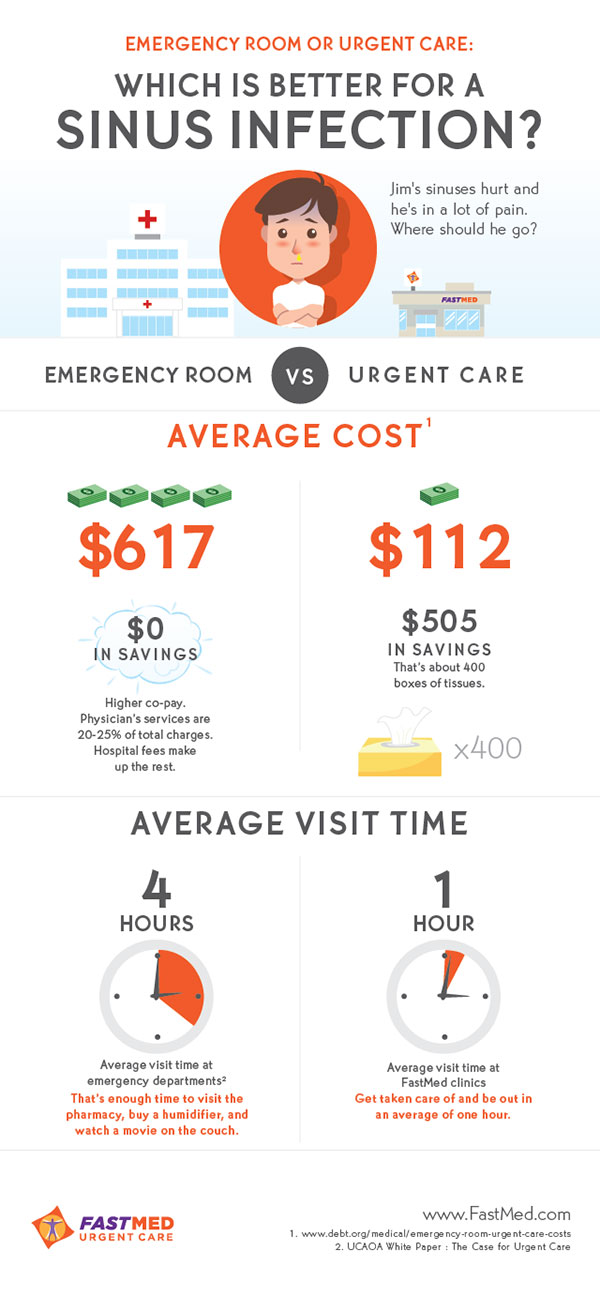
Your head is throbbing and you’re feeling serious pressure in your nose, cheeks and forehead. It’s deeply unpleasant, but you’ve been down this road before. You decide that you likely have sinusitis: a sinus infection.

Which is better for Sinus Infection? Infographic
Sinusitis
Sinusitis, also called rhinosinusitis, is an infection of the sinus cavities — the four paired spaces surrounding your nasal passages. These spaces are connected to your nasal passages through small channels called ostia, through which mucus drains. In sinusitis, viruses or bacteria invade the sinus cavities, usually as the result of a cold or of ongoing allergies. The resulting inflammation blocks the ostia, halting the flow of mucus and worsening the condition.
Sinusitis is very common, affecting about 1 in 8 adults annually.
Acute sinusitis
If left untreated, sinusitis can become acute, causing a lot of pain in the face and an unpleasant cloudy or colored discharge from the nose. You’ll also feel generally ill, often with a fever and a cough. Most of the time, symptoms start to improve in 7 to 10 days.
Should I see a doctor or nurse? — See your doctor or nurse if your symptoms last more than 7 days, or if your symptoms get better at first but then get worse.
Sometimes, sinusitis can lead to serious problems. See your doctor or nurse right away (do not wait 7 days) if you have:
- Fever higher than 102.5°F (39.2°C)
- Sudden and severe pain in the face and head
- Trouble seeing or seeing double
- Trouble thinking clearly
- Swelling or redness around 1 or both eyes
- Trouble breathing or a stiff neck
Is there anything I can do on my own to feel better? — Yes. To reduce your symptoms, you can:
- Take an over-the-counter pain reliever to reduce the pain
- Rinse your nose and sinuses with salt water a few times a day – Ask your doctor or nurse about the best way to do this.
- Use a decongestant nose spray – These sprays are sold in a pharmacy. But do not use decongestant nose sprays for more than 2 to 3 days in a row. Using them more than 3 days in a row can make symptoms worse.
You should NOT take an antihistamine for sinusitis. Common antihistamines include diphenhydramine (sample brand name: Benadryl),chlorpheniramine (sample brand name: Chlor-Trimeton),loratadine (sample brand name: Claritin), and cetirizine (sample brand name: Zyrtec). They can treat allergies, but not sinus infections, and could increase your discomfort by drying the lining of your nose and sinuses, or making you tired.
Your doctor might also prescribe a steroid nose spray to reduce the swelling in your nose. (Steroid nose sprays do not contain the same steroids that athletes take to build muscle.)
How is sinusitis treated? — Most of the time, sinusitis does not need to be treated with antibiotic medicines. This is because most sinusitis is caused by viruses — not bacteria — and antibiotics do not kill viruses. Many people get over sinus infections without antibiotics.
Some people with sinusitis do need treatment with antibiotics. If your symptoms have not improved after 7 to 10 days, ask your doctor if you should take antibiotics. Your doctor might recommend that you wait 1 more week to see if your symptoms improve. But if you have symptoms such as a fever or a lot of pain, he or she might prescribe antibiotics. It is important to follow your doctor’s instructions about taking your antibiotics.
What if my symptoms do not get better? — If your symptoms do not get better, talk with your doctor or nurse. He or she might order tests to figure out why you still have symptoms. These can include:
- CT scan or other imaging tests – Imaging tests create pictures of the inside of the body.
- A test to look inside the sinuses – For this test, a doctor puts a thin tube with a camera on the end into the nose and up into the sinuses.
Some people get a lot of sinus infections or have symptoms that last at least 3 months. These people can have a different type of sinusitis called “chronic sinusitis.” Chronic sinusitis can be caused by different things. For example, some people have growths in their nose or sinuses that are called “polyps.” Other people have allergies that cause their symptoms.
Chronic sinusitis can be treated in different ways. If you have chronic sinusitis, talk with your doctor about which treatments are right for you
Chronic sinusitis
For some people, sinusitis is an ongoing problem. They experience the condition very often, and when it appears, it’s resistant to treatment. These people may need to consider extra measures to treat their sinusitis. In some cases, chronic sinusitis is caused by nasal polyps or a deviated nasal septum, and surgical intervention may be the only way to find relief. If your sinuses give you constant problems, it may be time to talk to your doctor about the reason.
Sinusitis treatment
Many people simply go to their general practitioners to treat their sinusitis. However, if you don’t have a regular doctor or you can’t get an appointment quickly, you have two more options at your disposal: the emergency room, and an urgent care center.
The Emergency Room
Plenty of people use the emergency room for non-urgent conditions like sinusitis; in fact, the CDC estimates that only 12% of emergency room visits result in hospital admissions. But the emergency room can be an expensive and time-consuming option, even with health insurance. Kiplinger’s Personal Finance Magazine estimates that in 2011, the average in-network ER visit cost for an individual with private health insurance was a whopping $933. And, as for sinusitis itself, the average ER price tag in 2010 was $617.
Urgent Care
Urgent care centers, on the other hand, can save you a bundle. These free-standing clinics — often called “docs-in-a-box” for short — take patients with no appointment required, and are often open for extended night and weekend hours. They’re an increasingly popular choice; urgent care centers see between 71 and 160 million patients each year.
The average estimated cost of sinusitis treatment at urgent care clinics is $112. Compared to ER costs, that’s more than a $500 reduction! Also, because urgent care centers are designed primarily for non-urgent care, your wait time will be considerably lessened; you won’t have, for instance, a car accident victim or an appendicitis patient take precedence over you.
If you’re struggling with sinusitis, or any other unpleasant condition, come on in to FastMed Urgent Care — no appointment necessary! We can administer the antibiotics, steroid nasal sprays, or other treatments that will soothe your savage headache and get you back on your feet, fast.
About FastMed
FastMed Urgent Care owns and operates nearly 200 centers in North Carolina, Arizona and Texas that provide a broad range of acute/episodic and preventive healthcare services 365 days a year. FastMed also provides workers’ compensation and other occupational health services at all its centers, and family and sports medicine services at select locations. FastMed has successfully treated more than six million patients and is the only independent urgent care operator in North Carolina, Arizona and Texas to be awarded The Joint Commission’s Gold Seal of Approval® for quality, safety and infection control in ambulatory healthcare. For more information about locations, services, hours of operation, insurance and prices, visit www.fastmed.com.